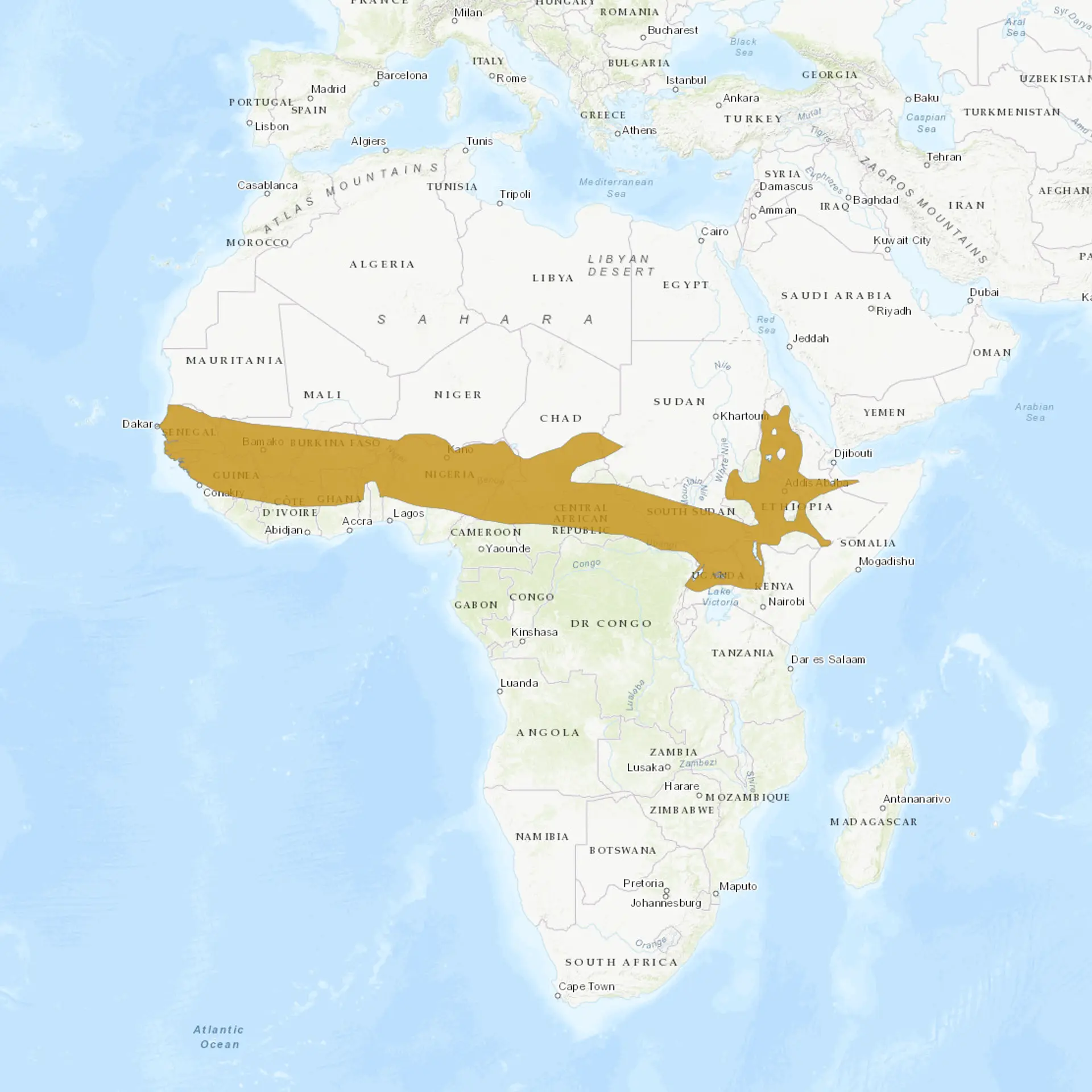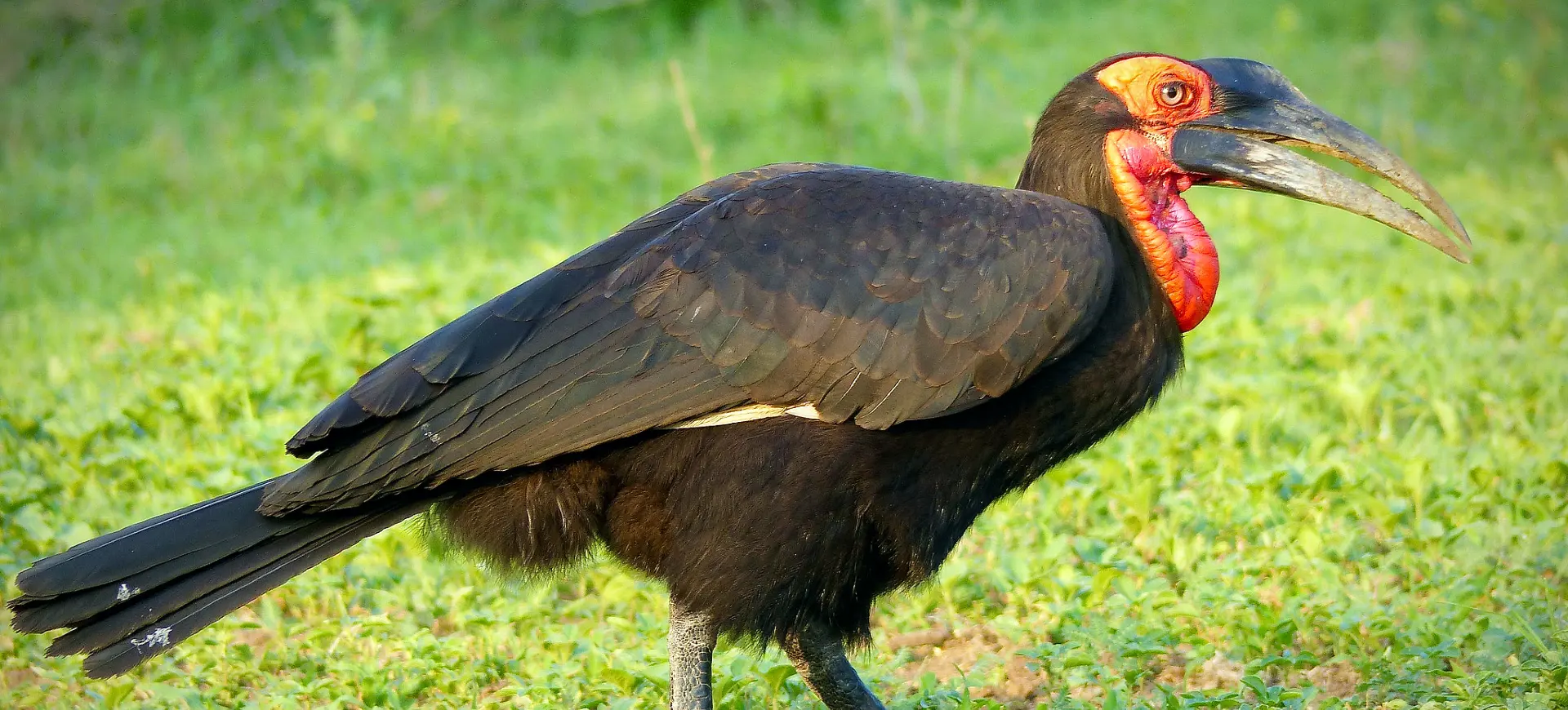Overview
The Abyssinian Ground Hornbill (Bucorvus abyssinicus) is a unique bird species native to the African continent. This bird stands out among its avian counterparts due to its largely terrestrial lifestyle, as opposed to the more arboreal lifestyle common among other hornbill species. The Abyssinian Ground Hornbill is considered an emblem of the African savannahs, with its presence adding to the region’s rich biodiversity.
This bird belongs to the Bucorvidae family, which comprises two ground hornbill species. The Abyssinian Ground Hornbill is the northern species of these two. This avian species is known for its distinctive appearance, characterized by its sizeable bill with a casque on top. The casque is a hollow structure that plays a role in amplifying the bird’s calls. In addition, males and females can be easily differentiated, as they exhibit sexual dimorphism in their coloring.
The Abyssinian Ground Hornbill is an integral part of its ecosystem. Its diet, which consists of a variety of small animals, helps control the population of certain species, contributing to the ecosystem’s overall health. The bird is also recognized for its interesting social and reproductive behaviors. It is generally seen in small groups and has a cooperative breeding system where the dominant male mates with one or two females, and the rest of the group helps raise the chicks.
Taxonomy
Kingdom
Phylum
Class
Order
Family
Genus
Species
Type
Current distribution:
The Abyssinian Ground Hornbill has an extensive distribution across the African continent. It is found throughout sub-Saharan Africa, from Senegal and Gambia in the west, eastwards to Ethiopia, and southwards to Kenya and northern Tanzania. However, its distribution is somewhat patchy due to habitat specificity, and it tends to avoid densely forested regions, deserts, and high-altitude areas.
Despite this broad geographical distribution, the species' population densities tend to be low, and sightings can be sporadic. This pattern is influenced by the bird's large territory size, slow reproduction rate, and low tolerance for habitat disturbance.
Physical Description:
The Abyssinian Ground Hornbill is a large, striking bird characterized by its deep black plumage, long, sturdy legs, and enormous bill. The bill, which is sizable even for a hornbill, is crowned by a prominent casque – a hollow structure that rests atop their beak. This casque is more developed and visually prominent in males, growing larger and more curved with age.
Both sexes have predominantly black plumage, but the color of their facial skin can easily distinguish them. Males sport a vivid red patch of bare skin around their eyes and throat, an absence in females. Instead, females possess a bluish skin patch in the same areas, providing an easy way to differentiate between the sexes. The Abyssinian Ground Hornbill’s eyes are framed by modified feathers, which look like eyelashes, another unique feature of these birds.

Lifespan: Wild: ~40 years || Captivity: ~50 years

Weight: Male: 6.6–14 lbs (3–6.4 kg) || Female: 4.4–9.9 lbs (2–4.5 kg)

Length: Male: 39–43 in (100–110 cm) || Female: 31–39 in (80–100 cm)

Height: Male: 35–40 in (90–100 cm) || Female: 28–35 in (70–90 cm)

Wingspan: Male & Female: 47-60 in (120-150 cm)

Top Speed: 18.6 mph (30 km/h)
Characteristic:
Native Habitat:
The Abyssinian Ground Hornbill is found in various habitats across sub-Saharan Africa. It prefers areas that combine open ground and scattered trees or shrubs, such as savannahs and grasslands. Its habitat preference also extends to lightly wooded areas and woodland edges. It generally avoids densely wooded areas, as its size and ground-dwelling habits make it less adept at moving through thick undergrowth.
Despite being a competent flyer, the Abyssinian Ground Hornbill spends most of its time on the ground. They use their long, strong legs to cover large distances for food. These birds perch on the tops of tall trees or cliffs at night, away from most ground-based predators.
Biomes:
Biogeographical Realms:
Continents:
Countries:
Diet:
Diet & Feeding Habits:
The Abyssinian Ground Hornbill is an opportunistic omnivore, feeding on various food items. Its diet includes insects, rodents, snakes, frogs, and other birds. It also consumes plant matter like seeds, berries, and fruits. They typically hunt by walking over their habitat and catching prey on or under the ground. Their powerful bill is used to dig into the soil, lift debris, and even break into the hard shells of snails or tortoises.
Their feeding behavior is adapted to their terrestrial lifestyle. For instance, they will chase insects in the grass, catch them with a swift peck of their bill, and toss them up before catching and swallowing them. Similarly, they capture rodents and small reptiles by stalking them and lunging forward with their powerful bill to grab the prey.
Mating Behavior:
Mating Description:
The Abyssinian Ground Hornbill exhibits an unusual mating system known as cooperative breeding, where individuals in a group collectively take care of the offspring. They are monogamous, and a dominant male usually mates with one or two females. During the courtship period, males engage in spectacular displays that involve bowing, bill-clashing, and loud calls to attract the female’s attention.
Once the female is ready to lay eggs, the breeding pair finds a natural cavity in a tree or rock crevice and modifies it to their liking. The female then seals herself inside the nest using a mixture of mud, droppings, and food materials, leaving only a small slit for the male to pass food through. She lays one to two eggs, which she incubates for approximately 37 to 41 days. During this period, the male is primarily responsible for foraging and providing food for the female and the hatched chicks.
Reproduction Season:
Birth Type:
Pregnancy Duration:
Female Name:
Male Name:
Baby Name:
Social Structure Description:
Abyssinian Ground Hornbills have a complex social structure, usually in groups of 2-8 individuals. These groups often comprise an alpha breeding pair and their offspring from previous years. Offspring usually stay with their parents for several years and help to raise younger siblings in a system known as cooperative breeding.
Group members communicate with each other through a variety of calls and body displays. They exhibit strong territorial behavior and use their loud calls to mark their territories, which can range from 2 to 100 square kilometers depending on the availability of resources.
Groups:
Conservation Status:
Population Trend:
Despite its broad geographical range, the Abyssinian Ground Hornbill has a relatively low population density throughout its habitat. This is largely due to the bird’s preference for extensive territories, slow reproductive rate, and relatively long lifespan. The species faces a decreasing population trend due to habitat destruction, hunting for body parts used in traditional medicine, and incidental poisoning and trapping.
Individual populations of this species are often localized and widely dispersed. As such, human-induced changes to their habitat can have significant impacts. The conversion of natural landscapes to agricultural fields and settlements, combined with illegal hunting, poses a significant threat to these birds.
Population Threats:
The main threat to Abyssinian Ground Hornbill populations is habitat loss due to agricultural expansion, deforestation, and human settlement. Their preference for certain habitats and the large areas these birds require make them susceptible to these changes. Additionally, they are hunted for their body parts, used in traditional medicine and for ornamental purposes.
Climate change also presents a significant threat to these birds. Temperature and precipitation patterns could affect the availability of food resources and suitable nesting sites. Furthermore, they face risks from incidental trapping and poisoning, as they often fall victim to traps and poisons intended for crop pests or larger game animals.
Conservation Efforts:
Conservation efforts for the Abyssinian Ground Hornbill mainly involve habitat preservation and the control of illegal hunting. Numerous protected areas within its range offer some degree of protection. Public awareness campaigns are also being carried out to inform local communities about the ecological importance of these birds and the need for their conservation.
Moreover, in certain regions, captive breeding programs are in place. Zoos and conservation organizations are working to breed these birds in captivity and, wherever possible, reintroduce them into the wild. International trade in this species is controlled under the Convention on International Trade in Endangered Species (CITES).
Additional Resources:
Fun Facts
- Abyssinian Ground Hornbills are one of the two largest species of hornbill.
- They can live up to 40 years in the wild.
- Females will seal themselves in a tree hole for incubation, relying entirely on the male for food.
- Despite their size and awkward appearance, they can fly.
- They perform a morning “duet,” a ritual where the pair sing together.
- The casque on their bill is hollow and helps amplify their calls.
- Their Latin name, Bucorvus, translates to “cow crow,” referencing their size and the crow-like color.
- They can eat venomous snakes and scorpions without being affected by the venom.
- A group of hornbills is called a “clatter.”
- They play an important role in their ecosystem by controlling pests and dispersing seeds.












